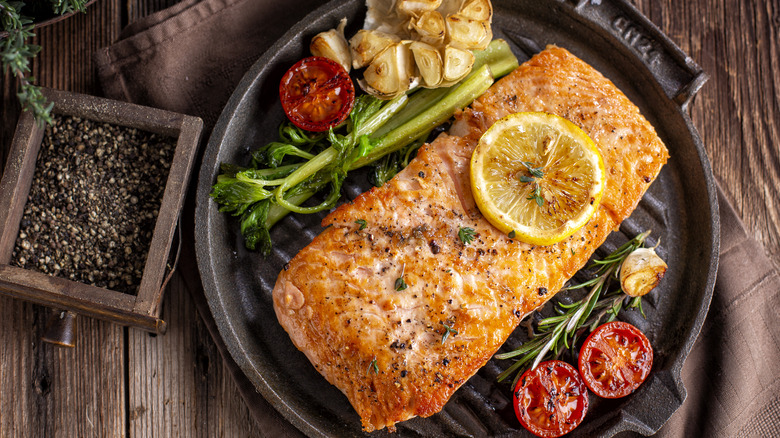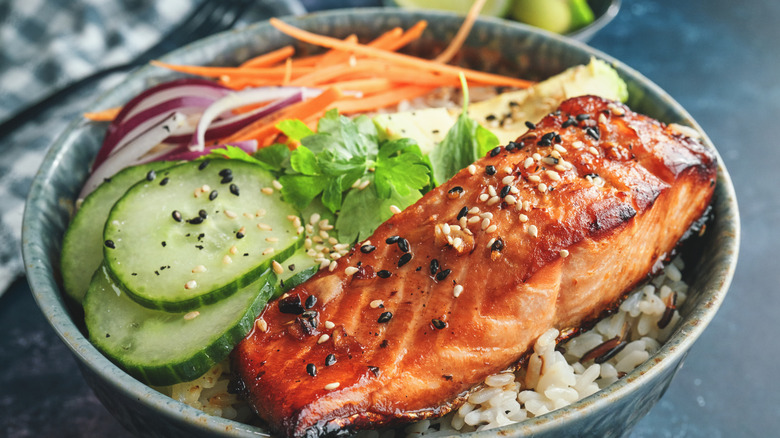For A Milder Fish Flavor, Soak Your Salmon In Milk
Nothing says disappointment like cooking a grilled salmon filet or poached salmon with dill sauce, only for the final result to taste too fishy for you. A mild choice like salmon is less susceptible to "off" flavors to begin with, but if you're a seafood skeptic and don't enjoy any fishy tastes whatsoever, warding them off quite simple. For salmon with a cleaner, milder flavor profile, all you need to do is soak it in milk for about 20 minutes.
Milk can actually draw pungent flavors out of fish, without imparting any strong flavor of its own. Furthermore, this technique reduces fishy odors in addition to taste, allowing you to cook salmon without stinking up your kitchen. After you've soaked the salmon, just make sure to pat it dry before cooking. Doing so is especially important if you plan to sear, broil, grill, or roast the salmon, because moisture is the enemy of these cooking methods. Any excess surface liquid will inhibit browning, making it harder to get a nice crust before the fish overcooks.
To be clear, this trick will not work for fish that has gone rancid; there's a major distinction between rotten seafood and a filet that tastes stronger than your palette prefers. Salmon that has gone bad will have an overwhelming sour smell and a mushy texture. If you see these signs, throw the fish out immediately.
How does soaking salmon in milk make it milder?
Some cooks may have never heard of the technique of soaking fish in milk, but it's actually been around for a long time. In fact, many recipes that call for this step date back to before the invention of refrigeration. To understand why this trick works, we need to look at what causes fish to tasting strongly in the first place.
Salmon is one of many species of fish that contain an organic compound called trimethylamine N-oxide (TMAO). When salmon is at its freshest, this compound is completely odorless and tasteless. As the fish ages, however, TMAO turns into a similarly named substance called trimethylamine. The byproduct of this transformation is that the salmon begins to taste and smell fishy.
Meanwhile, milk contains a protein called casein, and when salmon is soaked in the dairy, the casein binds to the fish's TMAO and reverses the chemical process that causes the compound to deteriorate. The salmon's strong odors and taste are thus neutralized. Lactose-free milk also contains casein and can be used interchangeably with regular milk, if you're lactose intolerant. Dairy-free milks do not contain this protein, however, so the jury is out on if they will work in the same way. Notably, acid also helps to neutralize the TMAO reaction, so squeezing some fresh lemon juice on the cooked salmon will also help.
Add flavor by soaking salmon in other liquids
There are plenty of other ways to marinate salmon in liquid to add flavor, as well as making the fish taste cleaner. For one idea, you can swap your milk out for buttermilk to add a tangy, bright element to the fish, along with the freshening effect of the dairy. Many southern recipes from the U.S. call for soaking catfish in buttermilk before cooking, much like a classic buttermilk fried chicken. Use the same idea for a salmon filet and serve it with southern-influenced sides, like grits or biscuits.
Don't mind the fishy taste of salmon? Your fish can still benefit from a soaking step. Brining salmon is a great way to create a juicy texture and season the fish flesh throughout. While brining meat can take hours, in order to produce a noticeable effect, you only need to soak salmon for 15 to 30 minutes. To make your brine, try dissolving a tablespoon of salt in each cup of water you use, adding whichever herbs and spices you please.
After a quick bath in the salty liquid and a stint on the stove, grill, or oven rack, the salmon will come out with an extra flaky, moist texture, and it will taste well-salted throughout. Just remember to pat the fish dry before cooking it up for perfect, crispy-skinned salmon with cilantro sauce or a nicely charred filet for a rice bowl.



